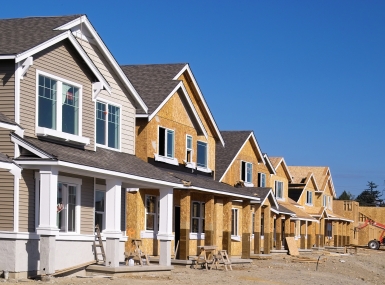Ballot measures offer keys to housing affordability
Author
Upcoming Events
Related News

Key Takeaways
A visitor, lost and wandering, spots a helpful-looking person.
“Excuse me,” he says, ‘I’m trying to find the train station. Do you know the way?’
‘Of course, I know several ways there,’ the local replies, ‘just not from here. So you decide.’
Elections feel like this same scene. Authorities know the destination but with so many routes, the right one is unclear. Voters often know the destination, but landmarks are unfamiliar and the decision is left to them. The complexity increases when the decision on the ballot is about affordable housing — both the route and the destination itself can be disorienting.
The higher profile of ballot measures
Decision-making on housing has great political salience and urgency, which is demonstrated through the increased policy debate in state capitols. In 2020, the National Conference of State Legislatures tracked 1,100 housing and homelessness-related bills in the legislatures of states and U.S. territories. By 2023, that grew to more than 2,700. Most voters neither saw nor heard much about them.
But the state and local government direction-setting on housing is changing. First, the affordable housing crisis means more state legislators and governors are making policy in zoning and land use — traditionally the domain of city councils, county boards and planning commissions.
A sampling of new state laws includes loosening regulations on parking requirements in new developments, fast-tracking local development permits, promoting density with duplexes, townhomes and accessory dwelling units and allowing dense housing development in commercial zones.
These are policies that get voters’ attention.
Municipal and county governments have mostly opposed this trend at state legislatures, and voters may soon get their say. A coalition led by local governments in California is pursuing an initiated referendum for November 2024 that would limit many of the land use and zoning bills enacted in Sacramento in recent years. Policymakers and elected officials are watching to see if a voter revolt will reverberate in states where legislators have reshuffled the hierarchies of local control in land use.
Voters are also deciding on how to pay for affordable housing. This includes more ballot measures — usually at the local level — for property taxes, bonds or other dedicated taxes to catalyze more affordable housing.
Voters have approved dozens of these local referenda in recent years at the county level (Buncombe County, N.C.; Palm Beach County, Fla.; Bernalillo County, N.M.; Boulder County, Colo.) and at the municipal level (Denver, San Antonio, Austin, Baltimore, Greensboro, Kansas City, Charlotte, Columbus, Seattle, Los Angeles).
State legislative gatekeeping
Pressure is being applied to the gatekeeper status that many state legislatures hold on local elections. In Minnesota, recent state law now requires localities to obtain a green light from the statehouse before forwarding a sales tax question to voters. Rochester, N.Y. took this route and voters responded by approving funds for housing and infrastructure. In the 2022 session, Colorado’s statehouse passed a bill allowing localities to seek voter approval for spending coveted tourism-related taxes on workforce housing and childcare. A majority of voters in dozens of cities and counties there have said “yes.”
Advocates and legislators in Massachusetts have advanced legislation to undo the state’s preemption on rent control and tenant rights and allow localities to put the question directly to voters. Ohio and Florida legislatures recently went a different direction, preempting local governments from enacting rent control or asking their voters to decide. Utah and Florida state legislators also passed laws that limit local voters’ abilities to challenge some zoning and land use decisions at the ballot.
There are many dimensions of the housing crisis where state legislatures will determine policy while local governments might prefer direction from local voters — not just on zoning and rent control and financing, but social housing, homelessness shelter and legal services to prevent evictions.
The election roadmap for 2024
The buildup of state and local housing debates indicates 2024 will be a landmark election cycle.
California voters will decide on removing certain state limitations on how local governments regulate rents. Another statewide measure in California will ask voters to lower the threshold for affordable housing bonds — a common funding strategy for local jurisdictions — to win at the ballot.
At the local level, voters will weigh in on dozens of housing-related elections across the entire calendar. The turnout of eligible-to-vote adults in some lower-profile elections (such as primaries and municipal elections in the spring and summer) may be as low as 20% but will climb as high as 80% in November, particularly in areas of presidential battleground states, and those states with highly competitive races for senators, governors, House members, and other local positions.
The persistence of the housing crisis means new solutions are needed. As policy decisions continue to find their way onto the ballot, in many cases, voters will be the ones setting the direction.
Ben Kelly is a public policy researcher and strategic communications consultant specializing in economic development, housing, urban planning, transportation and elections. This work was conducted as part of a project on state housing policy to advance NACo’s ongoing efforts on housing affordability.
Related News

Podcast: Eastern Tennessee counties invest in tourism during shutdown
Sevier County, Tenn. refused to let the government shutdown devastate its fall tourism draw—Great Smoky Mountains National Park. County Mayor Larry Waters describes the lengths he and his neighbors went to keep the park open. And NACo Chief Government Affairs Officer Mark Ritacco offers an outlook on what counties can take away from the shutdown and into the future.

Congress introduces Bipartisan HOME Reform Act
On October 21, 2025, Reps. Mike Flood (R-NE.) and Emanuel Cleaver (D-MO.) introduced the HOME Reform Act, which would make substantial changes to the eligible uses and exemptions applying to the Home Investment Partnerships (HOME) Program.

Chamber of commerce program helps keep workers on the job
Employers are thriving in Audrain County, Mo. because their workers are thriving, thanks to the local chamber of commerce's programming to help meet employees' needs.
County News
County News Hot Topics: Housing Affordability
